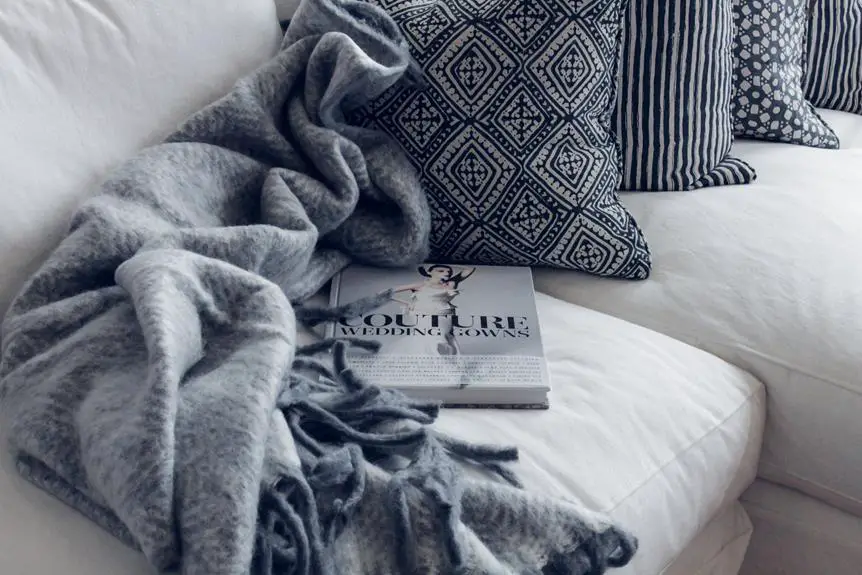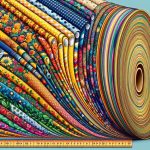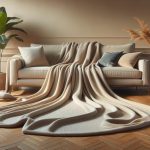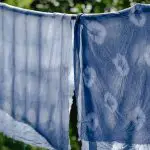Want to give your sofa a fresh new look but not sure how much fabric to buy? Calculating the right amount of fabric for sofa recovery can seem daunting, but with a few simple steps, you can master this essential skill.
By following the guidelines for measuring your sofa, considering pattern repeats, and factoring in upholstery style, you'll be able to confidently determine the yardage needed for your project.
Understanding how to adjust for piping and trimming will ensure you have all the fabric required for a beautifully reupholstered sofa.
With the right amount of fabric, you'll be well on your way to transforming your sofa into a stunning centerpiece for your living space.
Key Takeaways
- Start by measuring the length, width, and height of your sofa using a tape measure.
- Use the provided formulas to calculate the total length, width, and height in inches, and then convert to yards.
- Take into account pattern repeats and fabric directionality when calculating yardage and purchasing extra fabric.
- Consider the specific upholstery style of your sofa and factor it into the fabric yardage calculation, taking into consideration texture and color coordination as well.
Measuring Your Sofa Dimensions
You should start by measuring the length, width, and height of your sofa using a tape measure. Accurate measurements are crucial for ensuring that you purchase the right amount of fabric for recovering your sofa.
When measuring the length, start from one arm of the sofa, across the seating area, and all the way to the other arm. For the width, measure from the back of the sofa to the front. Finally, measure the height from the floor to the highest point on the sofa's back. Make sure to take these measurements at the widest and tallest points to account for any variations in the sofa's shape.
It's important to be precise because miscalculations can lead to purchasing insufficient fabric.
Additionally, when considering fabric selection, the accuracy of your measurements will directly impact the amount of fabric needed. Different fabrics have varying widths, so the length and width of your sofa will determine how much fabric is required.
Calculating Fabric Yardage
To calculate the fabric yardage needed for your sofa recovery, refer to the measurements you obtained for the length, width, and height of your sofa. Once you have these measurements, you can use the following formula to determine the amount of fabric required:
| Measurement | Formula | Result |
|---|---|---|
| Length | Length of sofa + 2 times the height | Total length in inches |
| Width | Width of sofa + 2 times the height | Total width in inches |
| Height | 2 times the height + 2 times the width | Total height in inches |
After obtaining the total length, width, and height in inches, add these three measurements together and divide by 36 to convert to yards. It's important to consider the fabric pattern and texture when calculating yardage. For example, if your fabric has a repeating pattern, you may need extra yardage to ensure the pattern matches up properly. Additionally, fabric with a more textured surface may require additional yardage to accommodate for pattern repeats and cutting layouts. Be mindful of these factors when determining the fabric yardage needed for your sofa recovery.
Considering Pattern Repeats
How can you ensure that the fabric yardage for your sofa recovery accounts for pattern repeats?
When considering pattern repeats, it's crucial to account for pattern matching and fabric directionality. Pattern matching involves aligning the fabric's pattern at the seams to maintain a cohesive look. Depending on the repeat size, you may need extra fabric to ensure that the patterns match up seamlessly. Additionally, fabric directionality, such as stripes or specific designs, requires careful consideration to ensure that the pattern runs consistently across the sofa.
To accommodate pattern repeats, it's advisable to purchase extra fabric. The amount of additional fabric needed will depend on the pattern repeat size and the dimensions of your sofa. It's essential to factor in both the vertical and horizontal pattern repeats, as they can affect the overall fabric yardage required.
Before purchasing the fabric, consult with the fabric supplier or manufacturer to understand the pattern repeat and directionality. This will help you make an accurate estimate and avoid running short on fabric.
Factoring in Upholstery Style
One important factor to consider when calculating fabric yardage for sofa recovery is the upholstery style, as it can significantly impact the amount of fabric needed. Different upholstery styles require varying amounts of fabric due to their unique designs and structures. When selecting fabric for your sofa recovery, it's crucial to take into account the specific upholstery style to ensure you have the right amount for the project.
Below is a table outlining the fabric yardage requirements for common upholstery styles:
| Upholstery Style | Fabric Yardage Required (Yards) |
|---|---|
| Tight Back | 12-14 |
| Loose Back | 14-16 |
| Tuxedo | 18-20 |
| Camelback | 16-18 |
| Lawson | 14-16 |
Understanding the upholstery style of your sofa will help you make an informed decision when selecting the fabric for recovery. Additionally, consider the fabric texture and color coordination to ensure a cohesive and visually appealing result. By factoring in these elements, you can confidently proceed with your sofa recovery project.
Adjusting for Piping and Trimming
You will need to account for the additional fabric required for piping and trimming when calculating the total amount needed for your sofa recovery project. Piping challenges and trimming techniques can add complexity to the fabric calculations, but with the right approach, you can ensure that you have enough fabric to cover these elements and achieve a professional finish.
Here are some key points to consider:
- Piping Challenges
- Piping adds dimension and structure to the edges of the sofa, requiring extra fabric for its creation and attachment.
- Measure the length of piping needed for the entire sofa and add this to your total fabric calculation.
- Consider the width of the fabric and how it will affect the creation of the piping for a seamless look.
- Trimming Techniques
- Trimming, such as gimp or decorative nails, can enhance the visual appeal of the recovered sofa.
- Account for the extra fabric needed to accommodate the trimming technique you choose.
- Ensure that the fabric quantity allows for any pattern matching or directional fabric placement around the trims.
Frequently Asked Questions
How Do I Know if My Sofa Is Worth Recovering or if It's Better to Buy a New One?
To decide if recovering your sofa is worthwhile, consider cost comparison. Assess the quality and condition of your sofa to determine if it's worth the investment. Evaluate your recovering options to make an informed decision.
Can I Use Different Types of Fabric for Different Parts of the Sofa, or Should It All Be the Same?
Yes, you can use different textures for various parts of the sofa, but ensure color coordination. Mixing fabrics adds visual interest. Opt for durable, easy-to-clean choices for high-traffic areas. Always consider the overall aesthetic.
Are There Any Special Considerations for Recovering a Leather Sofa Versus a Fabric One?
When recovering a leather sofa versus a fabric one, consider the maintenance differences, durability, and color selection. Leather requires specific cleaning and conditioning, but offers durability. Fabric allows for more color choices and may require less maintenance.
What Are Some Common Mistakes to Avoid When Calculating Fabric Yardage for Sofa Recovery?
When calculating fabric yardage for sofa recovery, common mistakes like inaccurate measuring techniques and neglecting fabric pattern and color coordination can lead to problems. Avoid these errors by double-checking measurements and considering the fabric's design and color.
How Can I Ensure That the Fabric I Choose Will Be Durable and Long-Lasting for My Sofa?
When choosing durable fabric for your sofa, consider factors like fabric maintenance and wear and tear. Look for materials like microfiber or leather for long-lasting durability. Regular cleaning and proper care can also extend the lifespan of your sofa fabric.
- How Does Ring Spun Cotton Affect Garment Fit and Shape Retention? - August 13, 2024
- What Are the Challenges in Producing Ring Spun Cotton? - August 13, 2024
- Is Ring Spun Cotton Suitable for Plus-Size Clothing? - August 13, 2024







